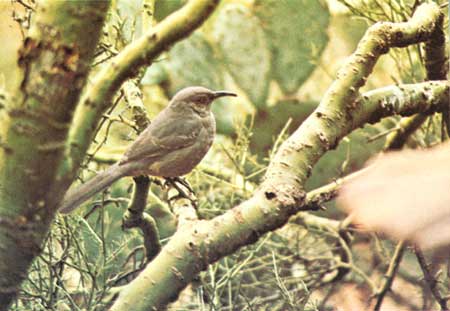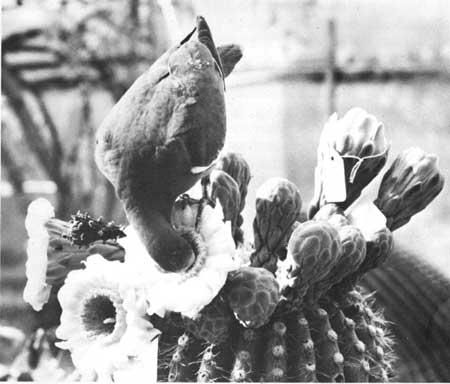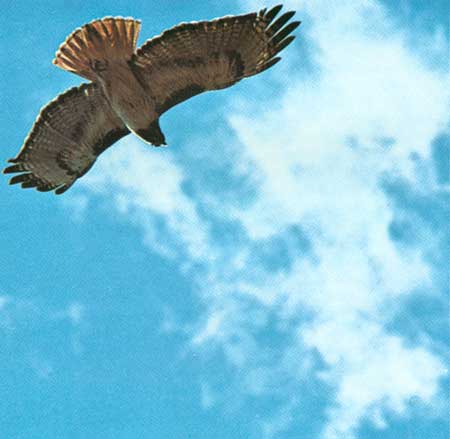|
SAGUARO National Park |
 |
animals and how they survive (continued)
Birds
Because of its great variety of habitats, ranging from luxurious desert vegetation to deep mountain forests, Saguaro National Monument provides food and shelter for many species of birds. Some of these reside all year within a single zone, while others move upward in summer, returning to the desert when the mountaintops are covered with snow. Other species pass through the monument in spring and autumn in their annual migrations between Latin America and summer nesting grounds in northern United States or Canada. The following species are those you are most likely to see.
A common year-round desert resident is the CURVE-BILLED THRASHER, noticeable, noisy, and about the size of a robin. These energetic inhabitants of the cactus forests nest in mesquite clumps and cholla thickets. Their diet—they feed on insects and succulent fruits—makes them comparatively independent of water. The thrashers are delightful songsters. The CACTUS WREN, looking somewhat like a small thrasher, is even noisier. It protects its nest by building in a cactus. This wren lives largely on a diet of insects, but about 17 percent of its food is seeds and fruits. One of the most attractive of the ground birds is the GAMBEL'S QUAIL. Many coveys are found throughout the desert within close range of water. In winter, Gambel's quail feed mainly on seeds, berries, and plant shoots; in summer they augment this diet with ants, grasshoppers, and other insects. The ROADRUNNER, ungainly clown of the desert, is frequently seen by visitors as it scuttles through the underbrush along the margins of sandy washes. Not particular as to food, it is sometimes seen with the tail of a lizard protruding from its beak, and it is known to eat insects and spiders, snakes, young rodents, small birds, seeds, and fruits. Quite capable of flight, the roadrunner prefers to trust to its legs and the security of thickets, but will take to its wings if pursued in the open.
 You may mistake the curve-billed thrasher's call, "whit-wheet,"for a human whistle of attention. (Photo by Fred E. Mang, Jr.) |
Two members of the woodpecker family closely associated with the saguaro cactus are the GILA WOODPECKER and GILDED FLICKER. Called carpenter birds because they drill nest holes or pockets in the saguaro stems, both species are of particular interest because of their limited range and specialized habitat. Two other desert birds, sufficiently similar to be confused, are the red, black-faced CARDINAL and the gray-and-red PYRRHULOXIA, both of which have crests. Look for these species in the shrubs along washes. Several kinds of doves are found in the desert, including the common MOURNING DOVE and the WHITE-WINGED DOVE. Mourning doves are all-year residents, while the large white-wings drift in from Mexico in May, remaining long enough to raise families and join other animals in harvesting fruits of the saguaro.
 The gilded flicker drills its nest hole in the saguaro. (Photo by Harold T. Coss, Jr.) |
Seen and heard in the desert all year, the canary-voiced HOUSE FINCH raises its family among cholla and mesquite thickets. The tinkling song of the ROCK WREN is a familiar sound in the desert in winter. These gray ground dwellers go farther north or to higher elevations to nest.
The PHAINOPEPLA is one of the most noticeable of the desert birds because of its silky crest, glossy black plumage, and habit of perching on the topmost branch of a tree while indulging in flutelike song. A permanent resident of the monument, subsisting on mistletoe berries and other vegetable matter in winter, it has a diet of insects, principally ants, during the rest of the year. Flycatchers are especially abundant and conspicuous during spring and early summer when the blossoms of trees, shrubs, and the larger cactuses attract swarms of insects. Among these birds are SAY'S PHOEBE and ASH-THROATED FLYCATCHER. The LESSER NIGHTHAWK lives on a diet of insects, which it catches while on the wing. It is especially noticeable from May to September as it skims the tops of the tallest saguaros in the dusk of evening. The lesser nighthawk also ranges up to the oak woodlands.
 The white-winged dove's interest in the saguaro is in the nectar and fruit. (Photo by George Olin) |
Predators are an integral part of the bird population, one of the smallest and most active being the LOGGERHEAD SHRIKE. This black-and-gray bird gorges itself on beetles and grasshoppers when insects are abundant, turning to lizards, rodents, and small birds at other times. It has the unusual habit of impaling its prey on thorns for future use. The RED-TAILED HAWK is the commonest of the large soaring hawks, which live mainly on rodents and reptiles. It builds its large stick nest in the forks of saguaro arms. Like the shrike and the SPARROW HAWK, the red-tailed hawk is found in grasslands, chaparral, and woodlands as well as in the desert. Because of their nocturnal habits, owls are not often seen by visitors, but they are abundant in the monument. In addition to the GREAT HORNED OWL, which like the red-tailed hawk feeds principally on rodents and builds cumbersome nests in saguaro branches, the SCREECH OWL and the tiny ELF OWL are numerous in the cactus community. Screech and elf owls make use of abandoned woodpecker holes in saguaros, not so much for nesting as for dark and comfortable hiding places during daylight hours; they emerge after sunset to hunt insects and small rodents. Best known of the carrion eaters, the TURKEY VULTURE is rarely seen on the ground, but is a common sight, singly or in groups, circling high in the sky.
The oak-pine-juniper woodland has its set of birds too. One of the noisiest, most quarrelsome, and most mischievous is the MEXICAN JAY, a permanent resident. In summer, it shares this habitat with the night-flying POOR-WILL, which closely resembles the nighthawk but lacks the white wing patches. Shy, secretive, and protectively colored, this bird is rarely seen, but its plaintive call is a familiar twilight sound at the middle elevations of the mountains. Here, too, is found the strikingly patterned HARLEQUIN QUAIL, which waits until you are almost upon it before flushing. The RUFOUS-SIDED TOWHEE prefers brushy slopes and canyons, where it trills its monotonous song from the branch of a skunkbush or scratches noisily and industriously among the fallen leaves beneath an oak. And anywhere from the oak-pine woodland to the top of the Rincons, you are likely to startle the large BAND-TAILED PIGEON from its perch.
 The red-tailed hawk builds its nest in the fork of a saguaro and by day ranges over the entire monument in search of prey. (Photo by Harold T. Coss, Jr.) |
The pine and fir forests of the higher Rincons are rich in bird life in summer, but only a few species remain the year around. Among the latter is the STELLER'S JAY, which includes insects in its summer diet but feeds mainly on acorns and other vegetable material in winter. The MOUNTAIN CHICKADEE is busy among the branches of the large pines and firs even when snow lies deep on the ground. PIGMY NUTHATCHES—tiny, constantly twittering insect-eaters—also remain all year.
In summer, when insects are plentiful, the mountain forests are alive with birds. The MEXICAN JUNCO, which winters at lower elevations, hides its nest in grass clumps among the firs and aspens. Hummingbirds of several species pause on vibrating wings to suck nectar from blossoms in the meadow at Manning Camp. Brightly colored summer visitors such as the HEPATIC TANAGER and the PAINTED REDSTART search for insects among the pine boughs or flash in the sunlight as they flutter across open glades in the forest. The mountaintops, too, have their predators; the COOPER'S HAWK, which nests in wooded canyons, is large enough to lift a pigeon or rabbit, but generally preys on rodents and smaller birds. The largest bird known to inhabit the Rincon Mountains is the TURKEY, which nests and raises its young among the firs and aspens. It descends in winter to the oak-pine woodlands, where it feeds on pinyon nuts, acorns, and grass seeds.
 The great horned owl, a nocturnal counterpart of the red-tailed hawk, nests in the saguaro and feeds primarily on rodents (left). Steller's jay lives year-round in the pine and fir forests of the higher Rincons (right). (Photos by Harold T. Coss, Jr.) |

|

|
|
|
|
Last Modified: Sat, Nov 4 2006 10:00:00 pm PST |


